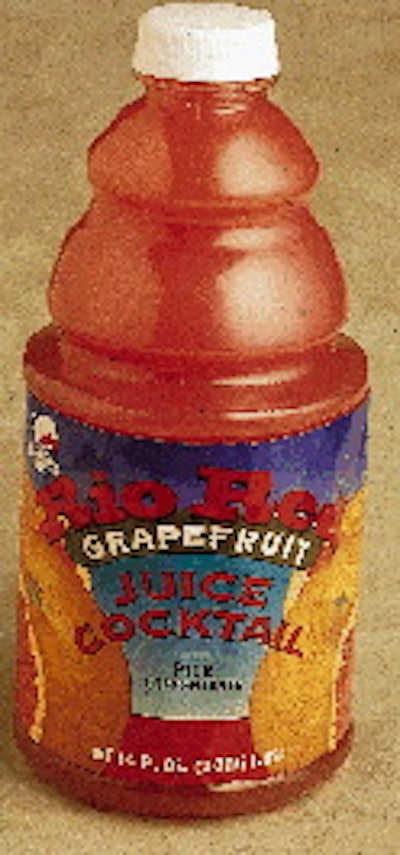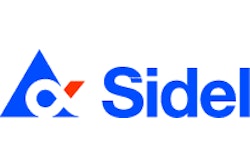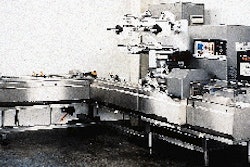Will cryogenic cooling become the next "hot" concept in molding polyethylene terephthalate containers? Plastic Solutions Molding (Plano, TX) and a handful of partnering firms are betting the answer is yes. PSM's chief executive officer Kurt Ruppman says his firm has applied for a patent on a method of stretch/blow molding monolayer PET preforms into heated molds then quickly chilling them with a mist of super-cold liquid nitrogen dispensed from the stretch rod. The resulting crystallinity in the PET bottle makes it capable of withstanding unusually high fill temperatures and enhances its gas barrier properties as well, claims Ruppman. One of PSM's primary targets is the hot-fill beverage market currently served by PET bottles that undergo conventional heat-setting, i.e., heated molds and either cool air or CO2 that is blown into the bottle. PSM believes its bottle, because it can be filled at 195°F to 200°F instead of 185°F, can deliver longer shelf life without added cost. For now, no applications of PSM's technology are on the market. Ordinarily Packaging World wouldn't cover this topic until a package was commercialized. But PSM presentations at Bev-Pak Americas '96 and '97, sponsored by Directions 21 Inc. (Sarasota, FL), sparked considerable interest. Here's a glimpse at what had conference attendees so intrigued. Part of their reaction, it should be observed, was skepticism. "That technology has been around for twenty years," grumbled one plastics technology consultant, who objects to "the notion that it's new or something that can be patented or licensed." Says another: "It's arguable how inventive he's been or whether the work is patentable. The patent office will make a determination on that." Similar work in the 70s PSM certainly has had precursors in this area. In the 1970s, pioneers at Owens-Illinois (Toledo, OH) developed and patented methods of using LN2 and other agents to cool PET blown into heated molds. Essentially O-I's process stopped the creation of spherulite crystals and encouraged long crystals. This produced PET bottles with superior thermal and barrier properties. By most accounts, these earlier efforts, while successful in the lab, never cleared the scale-up hurdle. Cost, technical complications, and the lack of a clear target in the marketplace are among the reasons cited. The timing was off, too, in that there weren't so many teas and fruit juices and isotonic beverages in single-serve bottles as there are today. PSM's technology proceeds along lines similar to O-I's. But Ruppman claims he's done more than merely imitate prior art. "We've created a whole different structure of crystalline particle," he says. While Ruppman's patent application is pending, full details on the process are only available to those who first sign a confidentiality agreement. According to Ruppman, those exposed to the technology, including a few Bev-Pak skeptics, "see the data they need to understand the change in morphology." He's referring to changes in the material's molecular structure. The confidentiality agreement makes it difficult to pinpoint the mold and LN2 temperatures that are involved. But some who are close to the technology say that the gradient between hot mold temperature and cold LN2 temperature is what separates Ruppman's work from those who came before him. "Hot molds and cooling with liquid nitrogen is not new," says Peter Weggeman of Directions 21. "But the extent to which he has gone in terms of very hot and very cold is new." Some clues about the temperatures involved are available from Kees Killestijn of PETPower (Etten-Leur, the Netherlands). He, too, is evaluating cryogenics, though he focuses on wide-mouth jars rather than narrow-neck bottles. "It's a matter of aggressively heat-setting the material," says Killestijn in describing his work. "You have temperatures of plus 160°C [320°F] outside and minus 140°C [284°F] on the inside. So the total temperature gradient is 300 degrees. That's where the unique crystallization comes in." The closest thing to a commercial application of PSM's technology is a hot-filled 64-oz bottle for Rio Red grapefruit juice, produced and marketed by Texas Citrus Exchange of Mission, TX. According to Pat Roberts, vice president of sales and marketing at Texas Citrus, this juice has been available in a conventional heat-set half-gallon PET bottle for about four years. Weighing 76 g empty, it's filled at 180°F and has a six-month shelf life. In March, for package evaluation, Texas Citrus filled, at 195°F, capped and labeled 400 of PSM's cryogenically cooled 64-oz bottles, each weighing 76 g empty. The higher fill temperature means better pasteurization, and, as Roberts puts it, "the more bacteria you kill, the better." Texas Citrus is conducting real-time analysis of the test bottles through November, and then it will decide if a switch is in order. LN2 tough to control Among the reasons previous practitioners of cryogenic cooling never enjoyed commercial success is because super cold LN2 is expensive and extremely difficult to control. If it's not carefully controlled, it can freeze valves and crack hoses. Enter BOC Gases (Murray Hill, NJ), whose R&D engineers and industrial cryogenics people engineered a computerized delivery system for the LN2 that permits pinpoint control of key parameters such as the nitrogen's pressure, temperature, volume and timing of delivery. When Ruppman first approached BOC, he needed precisely this kind of process control capability, says Ron Lee, principal engineer in BOC's R&D department. "Our familiarity with cryogenic cooling of plastic auto fuel tanks, blown films, and other plastic items made us an obvious source [for Ruppman]," says Lee. Within 18 months of first examining Ruppman's technology, Lee recalls, he was convinced "the bottles were for real. "We felt," he continues, "that if the cooling could be done controllably, and if we could make it possible to adjust the cooling conditions to specific targets, then we'd have a viable process." So BOC left the sidelines, where it had functioned as little more than a supplier of liquid nitrogen, and joined the game with PSM as a co-developer of the technology. The end result: a unique LN2 delivery system. The system BOC developed is also awaiting patent approval, so Lee is reluctant to describe it in great detail. But he emphasizes how "extraordinarily difficult" it is to consistently reproduce the precise cooling conditions required. "Liquid nitrogen can exist in a variety of thermodynamic states," says Lee, "and these states are a function not only of temperature but other factors as well, including pressure and speed of delivery. In developing this delivery system, we didn't know exactly what thermodynamic state we needed. "So we had to come up with a system that would let us produce, in a predictable manner, a range of thermodynamic states. That allowed us to lock in a particular state and return to it. Despite its considerable history in cryogenics, BOC was entering uncharted territory in its work with Ruppman. "In our other businesses, things like food, fuel tanks, films, it's ultimately about cooling and little more," Lee explains. "In this case, it's about more than cooling. We're stopping the growth of a certain kind of crystalline structure, a process so sensitive to the rate of heat transfer that we can't just put in a certain amount of cooling and say, 'There, we've removed the heat.' The requirements for this process are incredibly demanding." Lee is well acquainted with prior art and previous patents, and he speculates that earlier practitioners of cryogenic cooling of stretch/ blow-molded PET bottles made a key mistake when they failed to bring in cryogenics experts. "They were top-notch people and companies, but cryogenics is a unique field," says Lee. "There may have been some significant underestimating of the science and engineering required to control the liquid nitrogen." Ruppman believes BOC's control system is an indispensable component in his bottle-making technology. "They spent a lot of time on it," says Ruppman, "and it required a period of time where we made a lot of bad bottles while necessary parameters were being explored. But it was something that had to be done." More partners Two other PSM partners active in developing this technology are Electra Form (Vandalia, OH) and Ball Plastic Container (Atlanta, GA). Electra Form custom modified its RSB-2000 reheat stretch/blow-molding machine-designed originally for conventional stretch/blow conditions-for PSM's cryogenically cooled PET bottle. The two-cavity, intermittent-motion machine has a "racetrack" design that brings mandrel-mounted preforms past one bank of oven lamps, around a turn, and back into a second set of oven lamps before delivering preforms to the blow molds. The machine has a cycle time of 3.6 seconds, so cryogenically cooled bottles can be produced on the two-cavity machine at about 16/min. While that doesn't come close to most high-output rotary systems, it could be efficient for certain market segments-and at a fraction of the cost. The process of modifying an RSB-2000 for heat-setting purposes presented special challenges, primarily because the equipment must control extremely hot and cold temperatures in close proximity. Also, the BOC delivery system for LN2 had to be incorporated. From a blowing standpoint, the molds are electrically heated and zoned to allow variations in specific regions if the bottle requires them. Separate controls for sidewall and base were also critical, as Electra Form's Larry Beres explained at Bev-Pak '97 in April. "One must separate," Beres continued, "the hot and cold interface as much as possible to ensure the effectiveness of both. Shrinkage and metal tolerancing for these conditions are different from standard stretch blow molding, as is the residual shrinkage for the blown containers. All of these were painstakingly addressed and solved. A system for evacuating the gas quickly and efficiently, as well as sequencing for the process, required modifications to the normal parameters." Electra Form machines prepared for cryogenic cooling are designated RSB-HT models. Available in two- and four-cavity versions, they're offered with conversion packages that permit rapid change from heat-setting conditions to standard stretch/blow. Strategies PSM's plan is to first establish itself as a supplier of heat-set PET bottles with as many medium-output, intermittent-motion RSB-HT machines as demand requires. While PSM has no plans to get into high-speed rotary systems with its cryogenic cooling technology, that's where Ball Plastic Container comes in. Already a sizeable PET bottle converter with three plants in operation and two more soon to open, Ball sees strong potential in producing heat-set PET bottles via cryogenic cooling. The firm has exclusive rights for five years to sublicense the PSM technology worldwide, except for Canada. "Ball is working diligently to become a technology leader in PET containers," says Ball Plastic president Larry Green. "This technology provides some of that for us." Ball's interest in this technology is centered around three issues, says Green. "From a heat-set point of view, can you fill at higher temperatures? Second, can we lightweight? And third, will these containers have sufficient barrier for things like carbonated soft drinks, picante sauces, or pickles?" Ball's first objective is to sell bottles it makes on an Electra Form system. "I'd like to be selling bottles third quarter this year," Green says. But the firm is also working with PSM and BOC on a method of incorporating cryogenic cooling on a multi-cavity rotary system. Some industry observers are skeptical that such a combination can be achieved. "It boggles the mind to think of a liquid nitrogen delivery system for a rotary machine," says one technical management consultant who asked not to be identified. "When you go beyond one or two valving systems, you get yourself into one hell of a problem in timing, freezing, and precise dosing. It requires a rotary union system capable of dispensing the liquid nitrogen out to multiple molds through hoses, each of which must have its own valve. Just the wiring of such a system boggles the mind." Green says he's aware of such sentiments, and he acknowledges that distributing LN2 out to multiple molds under pinpoint control is indeed daunting. His response? "We're busy trying to prove it can be done." And who would use the cryogenically cooled, hot-fillable bottles produced on a high-output rotary system? Coca-Cola comes to mind-not for cold-filled carbonated soft drinks, but for hot-filled Fruitopia or Powerade. But all a Coke spokesman would say at present is, "We've evaluated some bottles and saw some interesting things, but we're still not sure how this technology applies to the Coke system." How about cryogenic cooling for PET bottles containing oxygen-sensitive beer? Would the O2 barrier suffice? "We have a 20- to 30-percent increase in oxygen barrier compared to a heat-set PET bottle blown on a conventional system," says Ruppman. "It's been substantiated by independent labs and by Ball in conjunction with a major beverage company. The bottles had the same gram weight and were made of the same PET resin, too." To make the beer bottle questions all the more intriguing, Electra Form's Beres says several brewers have tested heat-set bottles produced by PSM and have seen enough to take the next step. "That means building a beer bottle, not a 64-oz hot-fill bottle designed for juice," says Beres. "They need to know what the preform should look like, and how the blow mold can be optimized. I'm not sure when those steps will be taken, but I think it's going to happen pretty soon." So there it is, a heat-setting technology about which industry observers are either enthusiastic or skeptical. Speculate, criticize or applaud as experts do, in the end this technology will be judged by the same relentless force that judges all packaging technologies: the marketplace. Perhaps Beres puts it best: "Promising though it is, technology is never enough. Now it's a matter of getting the end users interested."





























